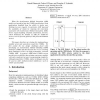Free Online Productivity Tools
i2Speak
i2Symbol
i2OCR
iTex2Img
iWeb2Print
iWeb2Shot
i2Type
iPdf2Split
iPdf2Merge
i2Bopomofo
i2Arabic
i2Style
i2Image
i2PDF
iLatex2Rtf
Sci2ools
LCTRTS
2001
Springer
2001
Springer
Designing an Efficient and Scalable Server-side Asynchrony Model for CORBA
When the Asynchronous Method Invocation (AMI) model was introduced into the CORBA specification, client applications benefited from the ability to invoke nonblocking two-way requests. In particular, AMI improved the scalability of clients by removing the restrictions associated with Synchronous Method Invocations (SMI). Server request handling remained synchronous, however, which minimized the benefits of AMI for middle-tier servers, such as firewall gateways and front-end database servers. This paper describes our strategy for implementing a scalable server-side asynchrony model for CORBA. We first outline the key design challenges faced when developing an Asynchronous Method Handling (AMH) model for CORBA and then describe how we are resolving these challenges in TAO, our high-performance, real-time CORBA ORB. In general, AMH-based CORBA servers provide more scalability than existing concurrency models, with only a moderate increase in programming complexity. Although targeted for C...
| Added | 30 Jul 2010 |
| Updated | 30 Jul 2010 |
| Type | Conference |
| Year | 2001 |
| Where | LCTRTS |
| Authors | Darrell Brunsch, Carlos O'Ryan, Douglas C. Schmidt |
Comments (0)

